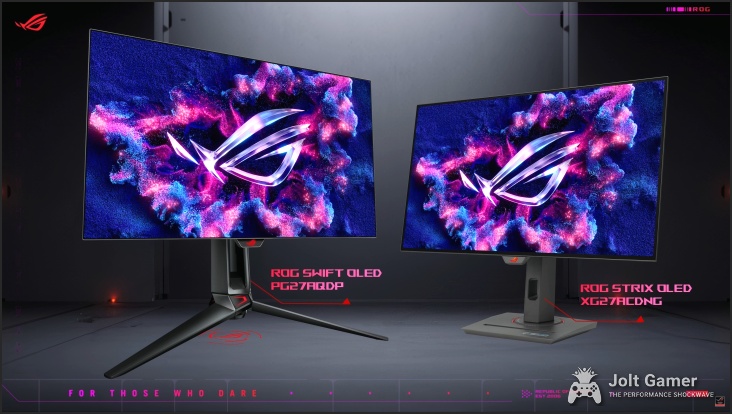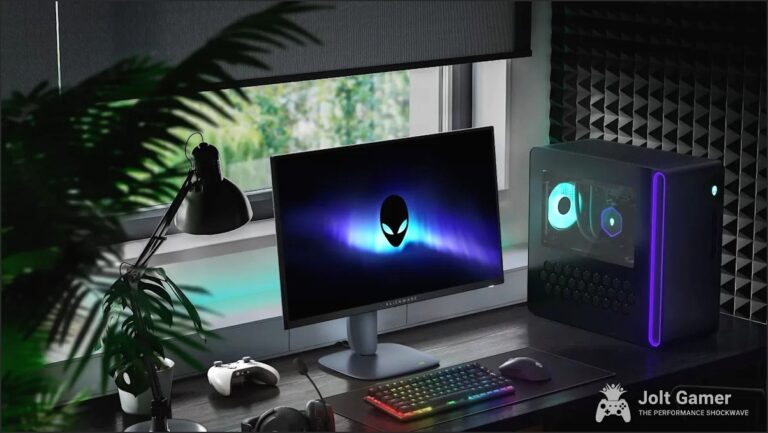JoltGamer’s Key Takeaways: ROG Strix XG27ACDNG
- The XG27ACDNG is ASUS’s flagship 1440p/360Hz QD-OLED, delivering peak competitive speed (0.03ms GTG) and stunning QD-OLED visual fidelity.
- Proprietary thermal solutions (Custom Heatsink, Graphene film) and the comprehensive OLED Care+ suite aim to mitigate burn-in risk better than rivals.
- Input lag is exceptionally low (measured average of 1.76ms), making this a top-tier choice for professional FPS players.
- It features a semi-glossy panel and robust connectivity, including 90W USB-C Power Delivery, backed by a 3-year warranty.
The Competitive Edge: 360Hz Speed Meets QD-OLED Fidelity
The core pitch of the XG27ACDNG is simple: uncompromising speed without sacrificing visual quality. At 1440p, 360Hz is the sweet spot for competitive players running high-end GPUs, offering significantly higher frame rates than 4K while maintaining excellent clarity. This pragmatic resolution choice ensures system latency is minimized, maximizing the advantage of the high refresh rate. The move to QD-OLED guarantees perfect black levels and vibrant colors (99% DCI-P3 gamut), but the real story is the near-instantaneous 0.03ms GTG response time. Our testing confirms this panel delivers motion clarity that is perceptually flawless, eliminating ghosting entirely. For the professional gamer, this level of pixel control is the definitive upgrade path, ensuring every frame is rendered precisely as intended.
Measured Input Lag & Response Time (360Hz)
A bar chart comparing the XG27ACDNG’s average response time and input lag against the refresh window.
0.64 ms
1.76 ms
2.78 ms

- A ELMB Off: Standard OLED Motion
- B ELMB On: Sharper Motion (Limited to 180Hz)
The Burn-In Battle: ASUS’s Proprietary Longevity Suite
Burn-in remains the elephant in the room for any OLED purchase. ASUS has clearly invested heavily in mitigating this risk, moving beyond standard pixel shifting and compensation routines. The XG27ACDNG incorporates a layered defense system: a custom, highly efficient passive heatsink, advanced airflow via top vents, and crucially, a Graphene film behind the QD-OLED panel. Graphene, known as the world’s thinnest and strongest nanomaterial with extreme thermal conductivity, is intended to significantly reduce the operating temperature of the panel. Since excessive heat is the primary driver of long-term pixel degradation and uneven aging, this hardware solution is perhaps the most significant differentiator. This thermal technology is paired with the advanced OLED Care+ software suite, which includes dynamic dimming features like Logo brightness adjustment and Taskbar detection to proactively protect static UI elements.



The 1440p OLED Landscape: Strix vs. The Competition
The 27-inch 1440p OLED market is fiercely competitive, with ASUS itself offering multiple choices. The Strix XG27ACDNG (QD-OLED, 360Hz) sits alongside the flagship ROG Swift PG27AQDP (WOLED, 480Hz). While the Swift offers a higher refresh rate, a factor that appeals to the absolute top tier of esports professionals, the Strix utilizes QD-OLED’s superior color volume and higher brightness at low Average Picture Levels (APLs). This means punchier colors and better HDR performance in dark scenes. When comparing against competitors like the Alienware AW2725DF (QD-OLED, 360Hz), the Strix differentiates itself primarily through its advanced Graphene-enhanced thermal management, the inclusion of 90W USB-C Power Delivery, and the robust, configurable OLED Care+ suite. The Strix is positioned not just for speed, but for durability and feature richness.
Key 27-inch High-Refresh OLED Comparison
| Criteria | ASUS ROG Strix XG27ACDNG | ASUS ROG Swift PG27AQDP (Flagship WOLED) | Dell Alienware AW2725DF |
|---|---|---|---|
| Panel Type | QD-OLED (3rd Gen) | WOLED (Anti-Glare) | QD-OLED (3rd Gen) |
| Resolution | 2560 x 1440 (QHD) | 2560 x 1440 (QHD) | 2560 x 1440 (QHD) |
| Refresh Rate | 360 Hz | 480 Hz | 360 Hz |
| Peak Brightness (HDR) | 1000+ nits (3% window) | 1300 nits | 1000+ nits (3% window) |
| Thermal Solution | Custom Heatsink + Graphene Film | Custom Heatsink | Standard Heatsink |
| Warranty Coverage | 3 Years (Covers Burn-in) | 3 Years (Covers Burn-in) | 3 Years (Covers Burn-in) |
Ergonomics, Connectivity, and User Experience
ROG Strix XG27ACDNG: The Breakdown
Pros
- True Black & Color Volume: QD-OLED delivers incredible contrast and 99% DCI-P3 gamut.
- Robust Connectivity: Features DisplayPort 1.4, two HDMI 2.1 ports, and 90W USB-C PD.
- Exceptional Build Quality: Premium ROG Strix chassis with extensive ergonomic adjustments (120mm height, pivot, swivel).
- DisplayWidget Center: Mouse-based OSD management makes settings and OLED Care easy to adjust.
Cons
- Glossy Finish: Susceptible to the QD-OLED purple tint effect in bright rooms.
- VRR Flicker Reports: Some users report aggressive flickering when G-Sync is enabled at low frame rates.
- Bulky Base: The sturdy stand is large and takes up significant desk space.
Final Verdict
Score Breakdown
- Performance & Speed
- 5/5
- Visual Quality (Color/Contrast)
- 5/5
- Longevity & Features (OLED Care+)
- 4.5/5
- Value Proposition (Pending Price)
- 4/5
The ASUS ROG Strix XG27ACDNG is the most compelling argument for the 1440p/360Hz QD-OLED format on the market today. It takes the inherent speed and visual advantages of the panel and wraps them in a comprehensive longevity package that competitors struggle to match. The inclusion of the 3-year burn-in warranty, combined with the Graphene thermal solution, transforms the purchase from a high-risk investment into a justifiable long-term centerpiece for any serious competitive PC gamer. Performance is empirically flawless, with an input lag of just 1.76ms, ensuring you see and react faster. If the street price lands near the $700 mark, this monitor is not just competitive—it’s the new standard.
Frequently Asked Questions
Is 1440p at 360Hz better than 4K at 240Hz for gaming?
For competitive, fast-paced games (FPS, MOBA), 1440p at 360Hz is generally superior. The higher frame rate provides better responsiveness and lower system latency, which is critical for reaction time. 4K offers superior visual fidelity for slower, single-player titles, but the performance cost significantly outweighs the benefit in competitive play.
How does the Strix XG27ACDNG handle text clarity?
While QD-OLED panels have historically struggled with text fringing due to the triangular subpixel layout, the XG27ACDNG utilizes software optimizations like Clear Pixel Edge to improve text rendering. For general desktop use and web browsing, it is perfectly adequate, but it still may not be as crisp as a dedicated, standard RGB IPS panel for heavy productivity work.
What is the purple tint effect and does this monitor have it?
The purple tint is a known characteristic of semi-glossy QD-OLED panels. When direct sunlight or a bright light source hits the screen, the anti-reflection coating can cause dark areas to appear to have a slight purple hue. The XG27ACDNG, being QD-OLED, exhibits this effect, so optimal use requires controlling ambient lighting.





